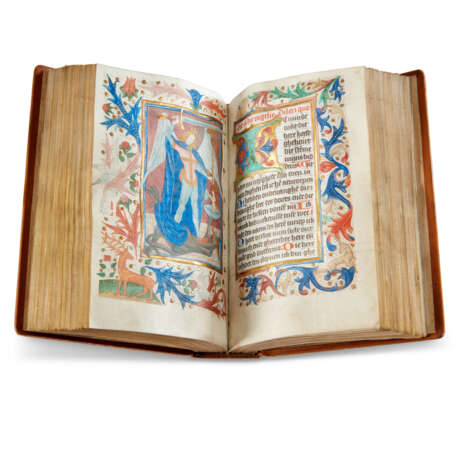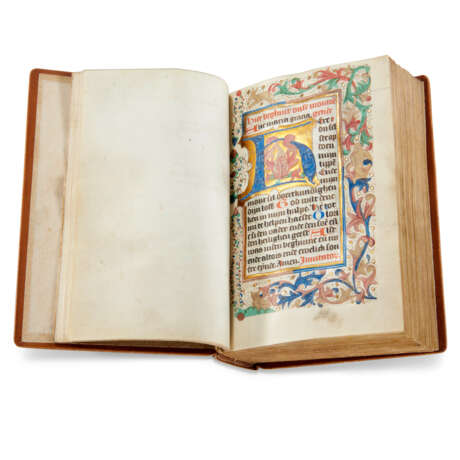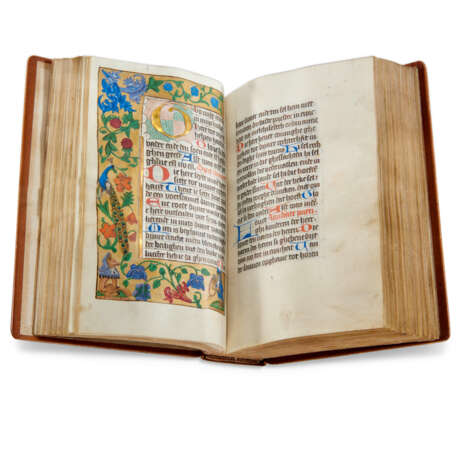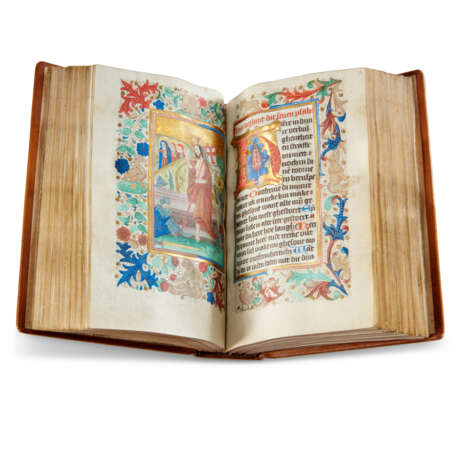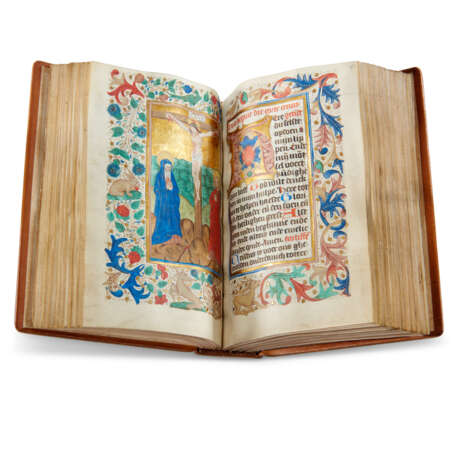ID 993264
Lot 54 | Follower of the Masters of the Delft Half-Length Figures and the Monkey Master
Valeur estimée
£ 18 000 – 25 000
Book of Hours, use of Utrecht, in Dutch with many incipits in Latin, illuminated manuscript on vellum [?Delft, c.1470 and 1490s]
A striking Delft Book of Hours illuminated in two phases.
167 x 114mm. i + 162 + i leaves. 19 lines of text, ruled space: 100 x 58mm, rubrics in red, text capitals touched red, one- and two-line initials alternately in red or blue, two- to four-line initials in blue flourished red or red flourished pink, all with green wash, three- to five-line initials in burnished gold on grounds of green and pink, green and orange, or blue and pink with white tracery, with extensions of scrolling acanthus in various colours, bar borders in burnished gold and colours, or panel borders depicting a variety of flowers, fruit and foliage and inhabited by birds, butterflies, foxes and monkeys, eight large initials (5-8 lines) with full bar borders inhabited by hares, monkeys, birds, stags, dogs, bears and a unicorn, 3 full-page miniatures on inserted leaves with similar borders (probably lacking other miniatures on inserted leaves, occasional minor smudges, recto of first and verso of last leaf pasted to modern endleaves). Modern brown morocco.
Provenance:
(1) The Hours of the Virgin are for the use of Utrecht; the appearance in red in the Calendar of both the feast and translation of St Lebuin may indicate a connection with Deventer to the east of Utrecht, while the Litany and Calendar include saints associated particularly with the conversion of the Frisians, Odulf, Adalbert and Swibert as well as Willibrord. The illumination shows links with both Delft and Utrecht but the text omits the feasts special to Delft.
(2) William Alfred Westropp Foyle (1885-1963): his sale, The Library of William Foyle, Christie's, 11-13 July 2000, lot 64.
Content:
Calendar ff.1-11; Office of the Virgin ff.13-56: matins ff.13-22, lauds ff.22-31, prime ff.31-35v, terce ff.35v-38v, sext ff.38v-42, none ff.42-45, vespers ff.45v-51v, compline ff.51v-56; Prayers to the Virgin ff.56v-58; Short Hours of the Cross ff.60-67; Penitential Psalms and Litany including Sts Lebuin, Radbod, Servatius, Odulf ff.69-85; Office of the Dead ff.87-109; O Intemerata, in Dutch ff.110-114; Prayer on the Seven Joys of the Virgin and prayer to the Virgin ff.114v-116; devotional exercises on the Passion with prayers to Christ and the Virgin for each of the liturgical hours ff.116v-126v; Prayer for forgiveness of sins ff.126v-127v; Seven Verses of St Bernard and prayer ff.128-129; Prayer to the Holy Face with 1000 days indulgence ff.129-130; a 'good prayer' to Christ ff.130-131v; Prayers on the Passion to be read before the Arma Christi ff.131v-132v; Prayer to be said at the consecration ff.133-133v; Prayer to be said kneeling at the Cross ff.133v; Prayers on the Five Wounds ff.134-137; Prayer on the Seven Last Words ff.137-140; Prayers to be said at the mass ff.140-140v; Prayer with indulgence of 6666 days ff.140v-141v; Prayers to the Trinity, the Cross, Holy Spirit, All Angels and St Michael, Sts Peter, Paul, John the Evangelist, John the Baptist, Andrew, All Apostles, Sts Stephen, Lawrence, Erasmus, Augustine, Martin, Nicolas, the Magdalen, Catherine, Barbara, All Saints ff.142-154; Hymn to be said on going to bed ff.154-155; Veni creator spiritus rubric in Latin to Dutch translation ff.155r&v; Prayer to be said at mass ff.155v-156v; Prayer given by an angel to St Bernard with different titles of the Virgin ff.156v-157; Prayers connected with the sacrament ff.158-162
Illumination:
The book was illuminated in two distinct phases, with later borders added to extend the marginal decoration on ff.31, 35v, 38v, 42, 45v, 51v and 114v. These are the work of the Monkey Master, active in Delft from around 1480, noted not only for the lively monkeys and other animals in his strongly coloured borders but for the variety of fruit and flowers (The Golden Age of Dutch Manuscript Painting, Utrecht and New York, 1990, pp.266, 277-278). His work here dates from towards the end of the century because all but the last of his borders are on painted or liquid gold grounds imitating the scatter borders, originated in the southern Netherlands from the 1470s, which became popular to the north from c.1490. His animals often parallel the text: on f.45v, for vespers of the Office of the Virgin, a fox in a canon's almuce listens attentively as a monkey in a clerical hood tells his prayer beads.
The original decoration may also have been executed in Delft, around 1470. The artist of the miniature of St Michael may have been responsible for the original border decoration and both borders and miniature show some links with the Master of the Delft Half-Length Figures (Golden Age, no 60). It was also common in Delft to illustrate the Office of the Dead with a St Michael. The more sinuous acanthus stems, with their dotted highlights, are, however, interspersed with gold disks each individually pen flourished, not linked on hairline tendrils, a characteristic of some Utrecht manuscripts, such as the Hours of Gijsbrecht van Brederode (Golden Age, no 65). The other two miniatures are less accomplished and more difficult to localise, since their direct depictions of familiar events could have appealed over a wide area.
The subjects of the full-page miniatures are as follows:
f.59v Christ on the Cross between the Virgin and St John
f.68v The Resurrection with the Three Maries in the background
f.86v St Michael, with a female soul in his balance, triumphant over the devil
The historiated initial on f.60 includes a heart pierced by two arrows
Special notice
No VAT is payable on the hammer price or the buyer's premium for this lot. Please see the VAT Symbols and Explanation section of the Conditions of Sale for further information
| Lieu d'origine: | Europe de l'Ouest, Europe, Les Pays-Bas |
|---|---|
| Catégorie maison de vente aux enchères: | Manuscrits médiévaux et de la Renaissance |
| Lieu d'origine: | Europe de l'Ouest, Europe, Les Pays-Bas |
|---|---|
| Catégorie maison de vente aux enchères: | Manuscrits médiévaux et de la Renaissance |
| Adresse de l'enchère |
CHRISTIE'S 8 King Street, St. James's SW1Y 6QT London Royaume-Uni | |
|---|---|---|
| Aperçu |
| |
| Téléphone | +44 (0)20 7839 9060 | |
| Commission | see on Website | |
| Conditions d'utilisation | Conditions d'utilisation |
